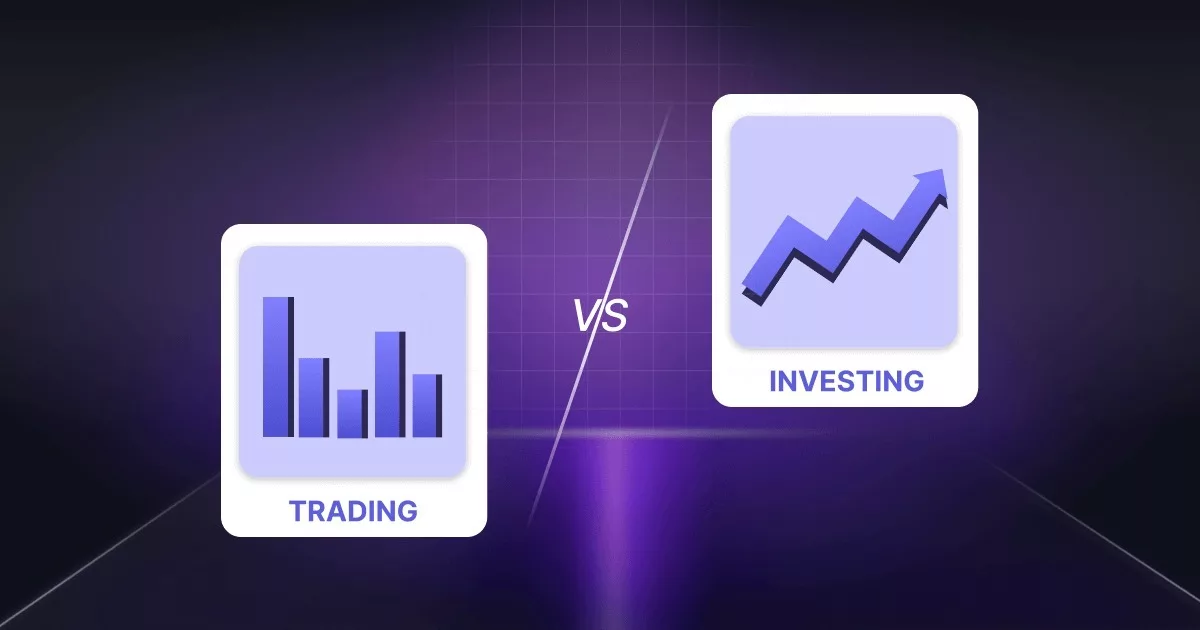
In the ever-evolving financial landscape, the debate between trading and investing remains at the forefront of many investors’ minds. For the typical investor, seeing is truly believing. And seeing the results of investing in Mudrex’s products instills confidence in our core principle- invest, don’t trade. But for the ones who are hesitant to take that first step, here’s something that might convince you. 97% of traders lose money trading. Astonishing, right? Now that we have your attention, let us take you on a journey.
Right now, you could be wondering how Coin Sets is an appropriate long-term investment for minimizing risk. Or how we can guarantee fixed returns using Vault on a crypto platform. You may also be curious about how these products, including Coins, are tailored for investing and why long-term investing should be appealing to you.
But before we delve into the reasons why investing outperforms trading, let us first examine the evolution of the financial system—from its trading roots to the sophisticated world of investing. The journey from traditional trading to the modern era, where a growing number of retail investors prioritize long-term investing, is a fascinating tale. As an authoritative voice in the financial world, let us guide you through this engaging and informative exploration of trading versus investing.
The Birth of Trading
Imagine a world without money, where people exchanged goods and services directly without any form of intermediary currency. It’s hard to envision in our modern world, but this was the reality for our ancestors, who relied on bartering to meet their needs and wants. Bartering allowed people to obtain resources they needed or desired by exchanging items they had in surplus.
The first recorded instances of organized trade date back to around 3000 BCE in Mesopotamia (present-day Iraq), where the Sumerians developed a system of writing called cuneiform, which was used to record transactions. Trade routes such as the Sumerian city of Ur and the Indus Valley civilization in present-day Pakistan and India were established, facilitating the exchange of goods like textiles, metals, and agricultural products.
As civilizations advanced and developed, the concept of currency emerged. The first known currency, the shekel, was used in Mesopotamia around 2500 BCE. The introduction of currency simplified the trading process and expanded the range of goods and services that could be exchanged.
The growth of trade networks led to the establishment of trading centers and marketplaces. The famous Silk Road, which connected the East and West, facilitated the exchange of goods, ideas, and culture between Europe, the Middle East, and Asia.
Over the years, trade continued to evolve with the development of more sophisticated financial instruments and the establishment of stock exchanges, leading to the modern global economy we know today. The primary goal of these stock exchanges was to increase liquidity in the market and provide a transparent platform for investors to trade securities.
Gradually, the idea of short-term trading emerged as investors began to see opportunities to profit from changes in stock prices over shorter periods of time. While vastly riskier, it was rewarding for a minuscule fraction of traders with the technical know-how to pull it off repeatedly.
The Shift Towards Investing
Fast forward to the present day, and the financial landscape has transformed dramatically. The rise of digital platforms, the proliferation of financial information, and the increased accessibility of global markets have led to a shift in focus for many retail investors. The appeal of long-term investing has gained traction, with an emphasis on wealth creation, risk mitigation, and financial stability.
So why has the tide turned towards long-term investing? Here are a few key reasons:
Efficient Market Hypothesis (EMH)
In the 1960s, Eugene Fama proposed the Efficient Market Hypothesis, suggesting that financial markets are efficient and that all available information is already reflected in asset prices. This theory challenged the idea of outperforming the market consistently through active trading and led to a growing emphasis on long-term investing.
Rise of index funds
The 1970s saw the introduction of the first index funds, which aimed to replicate the performance of a market index rather than actively picking individual stocks. This passive investment approach gained popularity over time as evidence mounted that passive strategies often outperformed active ones, especially when accounting for management fees and transaction costs. This encouraged more investors to focus on long-term investing.
Increased access to information
The rise of the internet in the late 20th and early 21st centuries democratized access to financial information, empowering individual investors to make more informed decisions. This development contributed to a shift in focus towards long-term investing based on fundamental analysis, as investors had more tools to research and assess companies and industries.
Behavioral finance insights
Starting in the late 20th century, the field of behavioral finance began to gain prominence, highlighting the psychological biases and heuristics that can lead to irrational investment decisions. For example, attempting to time the market perfectly is a near-impossible feat. Long-term investing negates this factor by focusing on time in the market, allowing investors to ride out short-term fluctuations and benefit from the overall upward trend of the market. Thus, as investors became more aware of the pitfalls of trading, many shifted their focus from short-term trading to long-term investing to minimize the impact of cognitive biases on their portfolios.
2008 financial crisis and market volatility
The global financial crisis of 2008 and subsequent market volatility have made many investors more cautious and risk-averse, prompting a shift towards long-term investing as a more stable wealth-building strategy.
The evolution from traditional trading assets to today’s emphasis on long-term investing is a testament to the adaptability of the financial world. As more retail investors recognize the advantages of long-term investing, the financial landscape will continue to evolve, fostering wealth creation and stability for those who embrace this approach. Trust in the wisdom of long-term investing, and secure your financial future in a fast-paced world.
Why Cryptocurrencies Are a Necessary Addition to Your Portfolio
14 years ago, when the world was introduced to Bitcoin, not a lot of people thought it would lead to much. But today, we have entire global corporations redefining themselves to accommodate an asset class that is undeniably a part of the financial system.
Cryptocurrencies have seen tremendous growth in the last decade, and currently, the groundwork has been laid for fast-paced growth in the blockchain space. When you invest in crypto, you are investing in the future.
Why You Should Invest Rather Than Trade in Cryptocurrencies
When it comes to cryptocurrencies, trading, especially day trading or short-term trading, requires constant attention to market movements and can be time-consuming. Crypto markets can be highly volatile, leading to significant price swings. And all of this adds undue pressure on traders, especially since cryptocurrencies are traded around the clock.
Investing with a long-term horizon allows individuals to spend less time actively managing their portfolio. Long-term investors are often less concerned with daily fluctuations and can remain focused on their long-term strategy, which can be less stressful compared to actively trading.
Moreover, long-term investing allows investors to capitalize on the power of compounding. By reinvesting the earnings generated from investments, investors can accelerate their wealth accumulation and enjoy exponential growth over time. Additionally, investing is a long-term prospect that capitalizes on the potential growth of the overall crypto market and specific projects, especially given the rapid pace of innovation in the blockchain space.
Mudrex’s Vision
Mudrex’s foundation was built with the vision of democratizing assets that were previously available only to the elite in the world of finance. One of our first offerings was Algos, a product that allowed expert traders to design their own trading algorithms that others could use to trade in cryptocurrencies. What was initially available only to the major financial institutions in the business became available at the click of a few buttons. But soon, it became apparent that this wasn’t as useful to the everyday crypto enthusiast as we’d hoped. So back to the drawing board!
After a whole lot of research, we realized that trading is just not everyone’s cup of tea. It has a high skill ceiling and takes up way too much time- something not a lot of us can spare. Add in the crypto market that trades 24/7, and it gets infinitely harder.
So in an asset class where people believe trading is the only way to build wealth, we developed products that help you invest for the long run and let your money do the work for you.
How Does Mudrex Help You Do This?
At Mudrex, we’ve designed products that are specifically geared toward the long-term investor mentality.
Coin Sets
Take Coin Sets, for example. These are baskets of cryptocurrencies based on popular themes in the crypto world.
Now, you might be bullish about a specific theme, say DeFi. However, rather than scouring the market endlessly to find the right asset among thousands of tokens, you can invest in Mudrex’s DeFi Tracker Coin Set. DeFi Tracker consists of the top DeFi tokens by market cap, and it is rebalanced on a monthly basis based on rules crafted by our in-house experts to ensure you stay on top of market movements.
Investing in Coin Sets helps you consistently stay invested in the top cryptocurrencies belonging to a wider theme. Thus, you are constantly up to date with the market while not having to actively spend time or effort on the manual tasks.
Vault
For the risk-averse investor who still wants to dip their toes in crypto, Vault gives you up to 10% fixed annual returns through the magic of stablecoins. Moreover, since you are invested in stablecoins that are backed by the US Dollar, any inflation that results in the USD gaining in value against the INR is money in your wallet on top of the fixed returns!
Coins
Coins are essentially what they sound like- individual cryptocurrencies you can buy. However, we have geared even this product towards long-term investment. Coins is designed to provide you with the fundamentals of a cryptocurrency to help you make a fully-informed decision. Moreover, all our products feature recurring investments, a system through which you can invest smaller amounts regularly rather than forcing yourself to enter the market at the “right time.”
Conclusion
Trading isn’t meant for everyone, but investing is. And investing in an asset as promising as cryptocurrencies is a no-brainer for any long-term investor. With Mudrex, invest in what you believe in and according to your risk appetite.
The best time to invest in cryptocurrencies was 14 years ago. The next best time is right now.




